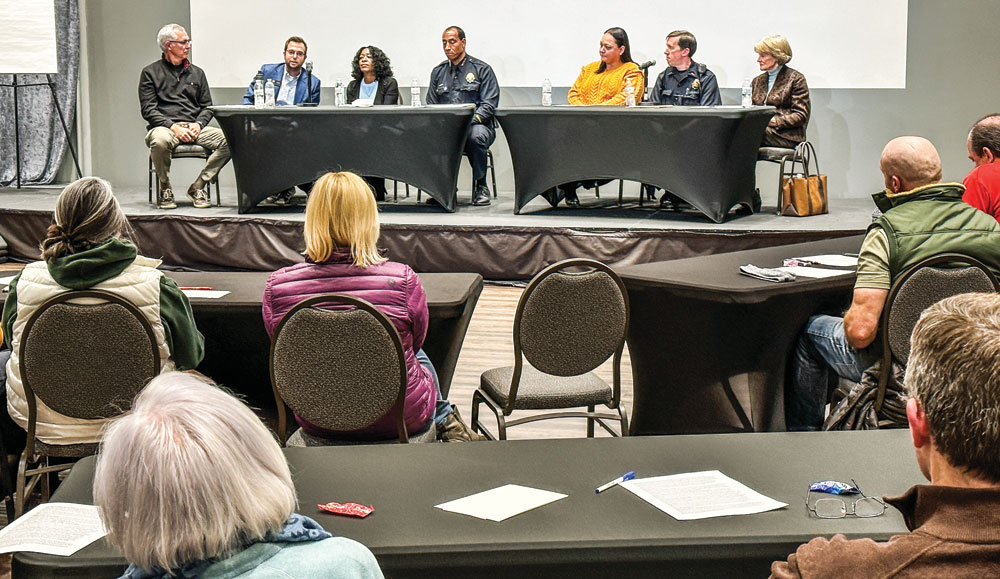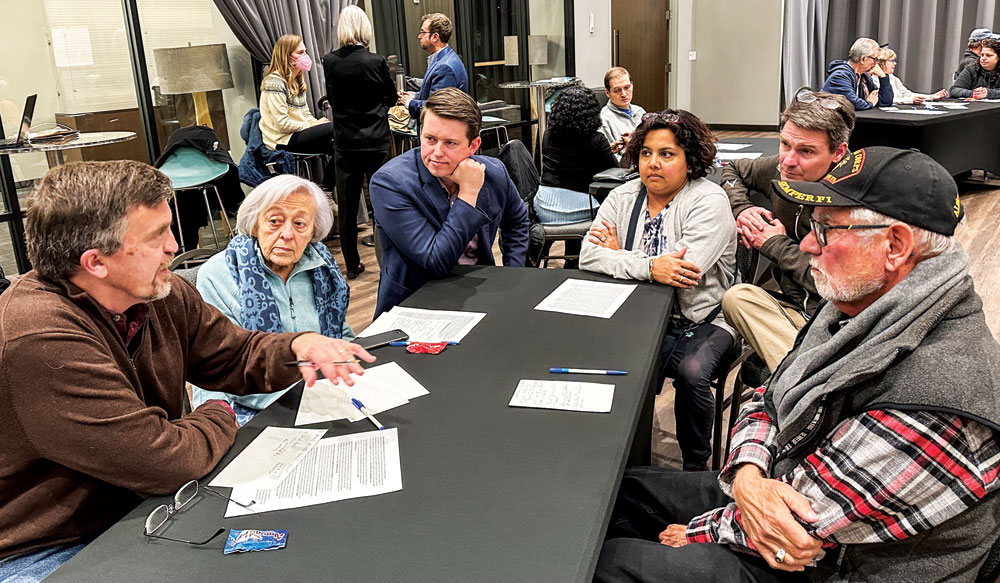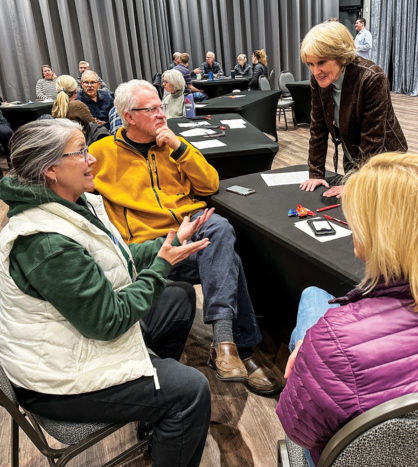
District Attorney Beth McCann, Police Chief Ron Thomas, and other community leaders spoke to nearly 50 Northeast Denver residents in a forum co-hosted by Front Porch and Central Park United Neighbors about ways to create safer neighborhoods for all citizens.
What does it mean to create a safe neighborhood? How can youth violence be prevented? How can school shootings be stopped? These were among the many complex issues discussed at the November 16 neighborhood forum sponsored by Central Park United Neighbors and Front Porch. More than 45 Northeast Denver residents gathered to hear from Police Chief Ron Thomas, District Attorney Beth McCann, and other city leaders and community advocates who discussed the perceptions and realities of crime in the area and what should be done to improve safety for everyone.
The first speaker, Vickie Wilhite from the non-profit group Together Colorado, set the tone for the night when she said that safe communities are ones where residents take care of their neighbors instead of fearing them. “We need each other and we are better off together…We believe power is in relationships.”

Some Northeast Denver residents spoke about the need to have better access to crime statistics to counter misinformation.
Chief Thomas expanded on that idea by saying that for too long the police and communities have been siloed. “The police have done their thing. Communities have done their thing. We need to break down those silos and work together.” He also said that it’s important that people’s perceptions of crime actually match the realities. “To me, a safe neighborhood is one in which people are not only statistically safe but they feel safe.”
DA McCann agreed and then turned to a theme that would dominate much of the evening’s discussion: preventing youth violence. “It would be nice to have a community where young men, particularly of color, didn’t feel that they needed to carry guns to feel safe. We see that too often, and that leads to things that aren’t good.” McCann said that youth violence prevention is one of the most urgent issues to be addressed, and she pointed to the city’s Handgun Intervention Program that tries to change the lives of young offenders who have been picked up carrying guns but who have not yet been caught using them. “We try to identify those kids at a young age and help them get connected with the community, to help them understand how to make better choices.”

Panelists at the forum listen to residents talk about their perceptions of crime and safety. From left to right: Moderator Bill Fulton, Civic Canopy; State Rep. Steven Woodrow; Vickie Wilhite, Together Colorado; Denver Police Chief Ron Thomas; Felicia Rodriguez, Denver Youth Violence Prevention Program; Police Lt. Kevin Hines, 5th District; Denver District Attorney Beth McCann.
As Denver’s Youth Violence Prevention Program Manager, Felicia Rodriguez talked about new community hubs that the City has opened across Denver to provide wraparound services to youth and families. Two are located in Northeast Denver: one at Amesse Elementary and one at Smith Elementary. “It’s important that youth have the support and services they need to thrive and be successful.” But she admitted that the city’s youth violence prevention program is still in its infancy and many of its partner programs need more funding.
State Representative Steven Woodrow was quick to agree. “We’ve underinvested in our communities, underinvested in our schools—especially in our communities of color. When you underinvest in people, they don’t get the same outcomes as folks in neighborhoods where you do invest. So there’s a gap. And it’s persistent.”

District Attorney Beth McCann speaks with Central Park residents Cheryl Fleetwood and Chris Adams during the small group breakout sessions.
One of the most emotional moments of the night came when Police Chief Thomas talked about how so many young people are filled with a sense of despair. “It has occurred to me for a while that one of the reasons there is so much youth violence–and youth essentially destroying their lives–is because they don’t have any hope.” Thomas’ voice cracked and he had to compose himself before continuing. “They don’t have hope for the future so they don’t think they’re throwing anything away.”
Police Lieutenant Kevin Hines, who commands Northeast Denver’s District 5 unit, acknowledged that many of the issues of crime and violence were generational, which means it will take time to break that cycle. He pointed to initiatives such as the co-responder program in which police are accompanied by mental health clinicians to respond to incidents involving people with mental illness or substance abuse issues. They ultimately help connect those people with services. “It’s been a huge success… so we’re making strides. But we’re looking at investments that will take years to pay off.”
After the six panelists spoke, the audience broke into small groups to discuss their ideas for solutions. When the forum reconvened, CPUN board member Jeff Barron told the panelists that his group talked about how Central Park, a more affluent community, seems disconnected from the communities that surround it. “Maybe some investment needs to go toward building true connections between our communities.”
Jamie Hodgkins spoke about how she was a senior in high school when the Columbine shooting happened. She now has young children and worries about their safety. “How do we create a community in America where we don’t worry about school shootings?”
Members of another group said they understand that investments need to be made for the long-term health of the community, but they worried about the short-term spike in property crimes and gun violence that has erupted. They wondered if crime statistics could be made more readily available—perhaps being published monthly in Front Porch—to counter misinformation spread on social media. Community police officers who attended the forum said those statistics are easily found by searching “crime statistics” at www.denvergov.org. DA McCann said her office also has a data dashboard available for the public at https://data.dacolorado.org/2nd/.
After the forum, Central Park resident Cheryl Fleetwood said she hoped that the people in attendance were inspired to get more involved. “I’m all for more investments but we don’t have to wait for that to take action ourselves. There are youth programs that exist right now that are desperate for volunteers. Volunteering is a great way to make meaningful connections and to create safer, stronger neighborhoods.”
Front Porch photos by Christie Gosch




0 Comments